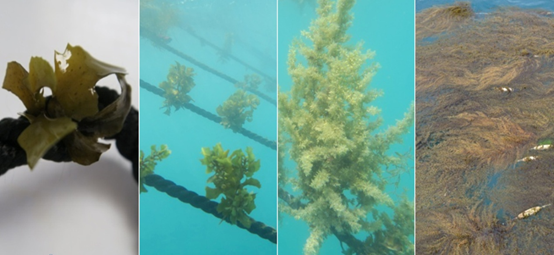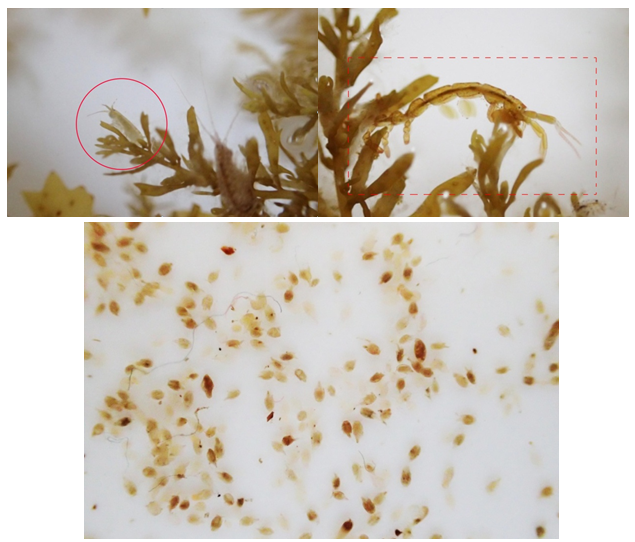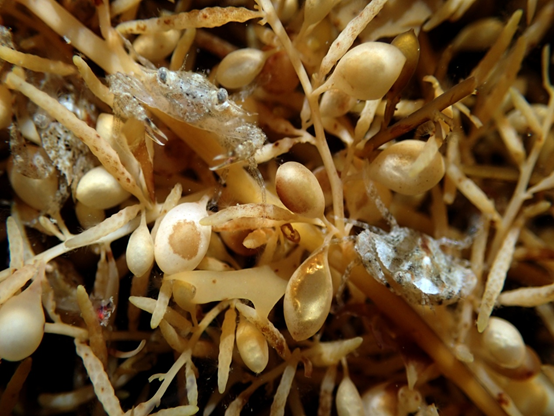To reduce the impact on coastal fisheries caused by the development of offshore wind farms, the Fisheries Research Institute set up an artificial algae farm in the waters off of Penghu Island that has been proven to be effective in trapping bait organisms, a good habitat for young marine life foraging, and a release field for some economic species like sand crabs. In addition to the positive benefits of increasing fishery resources, algae farms can also be used by manufacturers to set up in wind farms to give substantial feedback to fisheries, thus reducing fishermen's doubts about the development of wind turbines.
Chinese Sargassum hemiphyllum is a macroalgae commonly seen in the seas surrounding Taiwan. Researchers at the Penghu Marine Biology Research Center of Fisheries Research Institute have used artificial ropes of Chinese Sargassum hemiphyllum to form an artificial algae farm. Their test results show that algae has a better growth rate during fall and winter seasons, the reproductive tray mature by the end of spring, and after new seedlings are propagated through the fertilized eggs, the algae detach, and only the appendages survive the summer. When seawater temperatures begin to drop in the fall, the algal seedlings on the appendages grow again.
Institute researchers set up algae ropes attached to the Chinese Sargassum hemiphyllum seedlings in December. At this time, the algae seedlings are about 2 cm in length. The algae then grow rapidly, and its length can reach 40cm or more by the middle of March, thus attracting the inhabitation of copepods and amphipods or other feed for plankton, and algae ecosystems take shape. By April, the algal reproductive trays proliferate and mature. In addition to rich bait organisms, great numbers of fish, crustacean, and cephalopod seedlings are also attracted to the algal forest under or around the algae bed. After May and the ovulation of mature algal reproductive trays, the dense fronds begin to fall off, and many organisms that have inhabited them leave with the drifting algae and spread out, thereby enriching the fishery resources in the adjacent sea area.
The Fisheries Research Institute has stated that the Pacific blue swimming crab, commonly known as the sand crab, is one of the more important economic crab species along this offshore area. The Penghu Marine Biology Research Center has successfully established a complete set of technology for its breeding, but it is often difficult to mass-produce the crabs due, because they fight each other for food. Therefore, at present, artificially cultivated sand crab seedlings are released to increase resources, but the benefits of the traditional form of release are not good as the groups of crabs do not easily spread out and are preyed upon by fish. In recent years, the breeding process has changed to make juvenile crabs grow to a suitable carapace width with an enhanced ability to avoid predators and to better adapt to the wild environment, and then they are released at night. Although this type of release can improve efficiency, it still cannot effectively solve the problem that the crab seedlings do not easily survive. However, by using artificial algae farms, sand crab seedlings are able to grow rapidly after release and can reach their average 1-month size in just 20 days due to the multi-layered three-dimensional space and rich bait organisms. Moreover, there is no need to feed bait to them, which saves a lot of human and material resources, and when the mature algae detach, the sand crab seedlings attached to the algae will drift along with the current, thus achieving the purpose of natural diffusion for these crabs.
The Fisheries Research Institute has noted that the collection of sargassum fertilized eggs and the improvement of epiphytic seedlings and cultivation techniques are currently under development, which will make the construction of artificial algae farms more effective. At the same time, it is further developing technologies for the application of different algae and the release of other economic species to make the construction and application of artificial algae farms more complete, so as to effectively enrich fishery resources along the offshore areas of Taiwan.
Penghu Marine Biology Research Center

Figure 1. An artificial algae farm built using Chinese Sargassum hemiphyllum seedling ropes. Left: Chinese Sargassum hemiphyllum seedlings. Middle: Growth of algal seedlings at different periods. Right: An artificial algae farm built with Chinese Sargassum hemiphyllum.

Figure 2. Platorchestia platensis (top left), skeleton shrimps (top right) and copepods (bottom) inhabiting sargassum forests

Figure 3. Multi-layered sargassum forests provide shelter for sand crab seedlings and can offer a living culture with high density.